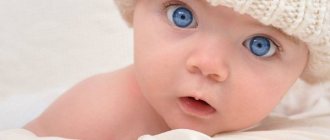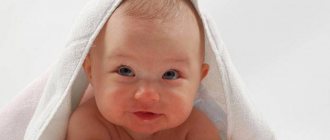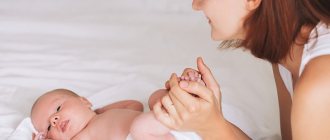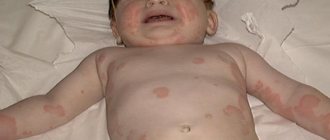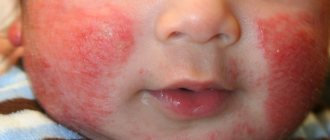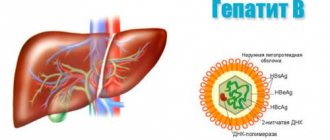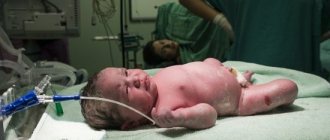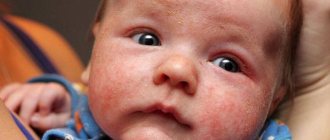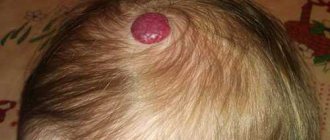by Doctor
Categories:
- Allergy treatment
Hello, dear readers. Today we are talking about the main differences between flowering in newborns and allergies, and what the main symptoms parents should know.
Flowering in newborns is a completely harmless disease. These are pimples (rashes) on the baby’s face. Parents may confuse newborn blooms and allergies.
Therefore, from the moment a child is born, mothers and fathers should know how to distinguish allergies from flowering in newborns.
After all, allergies are not as harmless a disease as flowering, and usually do not go away on their own.
Why does flowering occur in newborns?
Flowering (hormonal rash), as statistics show, occurs in most newborns.
While the baby is in the mother's womb, the mother shares with him not only valuable nutrients, but also hormones.
The child is born, hormones continue to enter his body with milk during breastfeeding.
There may be an excess of them, and then newborns develop a hormonal rash, popularly known as bloom.
Doctors also call blooming an adaptation allergy: the baby (his digestive system) needs to get used to the new diet.
A mother should remember this and eat properly and safely for her infant.
In addition, flowering can be caused by excessive activity of the sebaceous glands in newborns (the cause is again hormones, their excess: the ducts on the baby’s skin are blocked).
None of the reasons for flowering indicate any abnormalities in the baby’s body. Experts consider flowering to be a physiologically normal phenomenon.
There is no need to treat such manifestations; very soon the newborn’s body will cope with this phenomenon on its own.
The skin will clear as all systems return to normal, and foreign elements (mother’s hormones) will either be removed from the body, or the newborn’s body will adapt to them.
In fact, flowering acts as a kind of adaptation measure for a newborn.
Of course, in the case of a large rash during flowering, the pediatrician can recommend traditional medicine: lotions made from decoctions of string and chamomile, which have long been known among the people. Herbs are also used for baths.
Sometimes a doctor prescribes zinc ointment (it dries out pimples), hydrogen peroxide (use cotton swabs with ointment on them no more than twice a day), Bepanten ointment (apply once or twice a day in a thin layer).
But more often than not, no even the mildest treatment is required at all. You just need to maintain perfect cleanliness, and also eat right for your mother.
The main differences between flowering and allergic reactions in infants
The main difference between flowering and allergies in a baby is that rashes during flowering do not cause any discomfort in the baby: the skin does not itch, does not flake, does not itch.
Whereas in allergic processes, any skin damage causes painful itching and burning. If a child has a rash on the skin, parents are concerned about a natural question: allergies or newborn bloom: how to distinguish them from each other?
During flowering (which, as mentioned above, is a physiological norm for newborns), in no case should you independently use hormonal drugs to level out the hormonal levels.
Squeezing pimples is also strictly prohibited, as is resorting to the use of all kinds of ointments and creams not prescribed by the pediatrician. Very soon, mothers and fathers will completely forget about this condition in newborns, such as flowering.
It is believed that the maximum duration of flowering is several weeks, and it can begin approximately a couple of weeks after the birth of the child.
It’s a different matter if a child has an allergy hidden under the guise of flowering.
How and with what to treat?
Since flowering in infants is considered normal, it is not advisable to treat it with medications. In the absence of infectious complications, white dots disappear on their own within 5-10 days. In addition, if the hormonal rash is not extensive, you can use folk remedies.
Chamomile baths
When the first signs of flowering appear in newborns, take a chamomile bath as a preventive measure. To prepare it, you need to pour 30-50 g of chamomile flowers into 1 liter of boiling water. After 4-5 minutes, strain the resulting infusion and pour into the bath. Then fill with warm water. The finished broth should be light yellow in color.
Linden flower baths
Linden flowers are used to prepare them. It is necessary to pour 10-15 g of linden with 2 liters of boiled water, let it brew for an hour, strain and pour into the bathroom. After taking a bath, wipe the baby's skin dry with a clean towel.
Oak bark baths
Oak bark not only has calming properties, but can also boost the immune system. To prepare the treatment procedure, you need to have 50-60 g of finely chopped bark. Pour 5 liters of water and boil for 2-2.5 hours. The finished broth can be poured into the bathroom.
If your baby has blooms on his cheeks or in his mouth, then there is absolutely no need to take baths. Parents can treat the skin 3-4 times a day with cotton pads soaked in a decoction of any medicinal herbs. But, despite this, bathing is considered more beneficial for the skin of infants, and it is worth preferring them.
Ointment
To prepare it, mix the white of 1 egg with a spoon of vegetable oil (almond, peach, olive, sunflower). Use this mixture to lubricate your cheeks several times a day. After a couple of weeks, flowering will go away on its own. After 15-20 minutes, you can wash it off and wipe your face dry.
Jojoba oil
It has an excellent effect on the baby’s skin and serves as a preventative against flowering. Use it to lubricate your cheeks a couple of times a day. Thanks to this oil, inflammatory processes are relieved and wounds heal. More information about jojoba oil can be found on medical forums or websites.
What if it’s not a bloom, but an allergy?
Allergies in infants require quick and qualified action from a specialist.
How to distinguish allergies from flowering in a baby? The cause of allergies in infants may be the mother's consumption of allergenic foods during pregnancy and breastfeeding, and, of course, a hereditary factor.
- With allergies, changes in the skin itch and torment the baby, he is irritated, cries, and sleeps poorly.
- When flowering, the rash is localized mainly on the face (nose, cheeks, forehead) and neck, affecting the scalp. Rashes of allergic origin occur throughout the body, but crumbs on the head under the hair are extremely rare. The places where an allergic rash appears is always associated with an allergen: if the irritant is diapers, the rashes are observed on the baby’s bottom; if the allergen was washing powder, the rash will appear on those parts of the body that come into contact with washed baby clothes; if skin irritations are caused by food allergies, most often they will appear not only on the face, but also on the palms and feet of the child.
- Allergic reactions are characterized by dry skin and flaking.
- The blooms are groups of small red or pink pimples, each pimple has a tip and a white dot in the center, the contours of the pimple are unclear. Pimples can also be single. Allergy skin lesions in newborns most often appear as flat red spots or a small red rash without tops. The spots have a clear outline. Most often, doctors diagnose hives caused by food allergies.
- With allergies, the functioning of the newborn's gastrointestinal tract is regularly disrupted (stool disorders, flatulence, abdominal pain), which does not happen during flowering.
There are many types of allergies accompanied by skin lesions. This includes atopic dermatitis, a rash due to the baby’s hypersensitivity to certain medications, urticaria, and contact dermatitis.
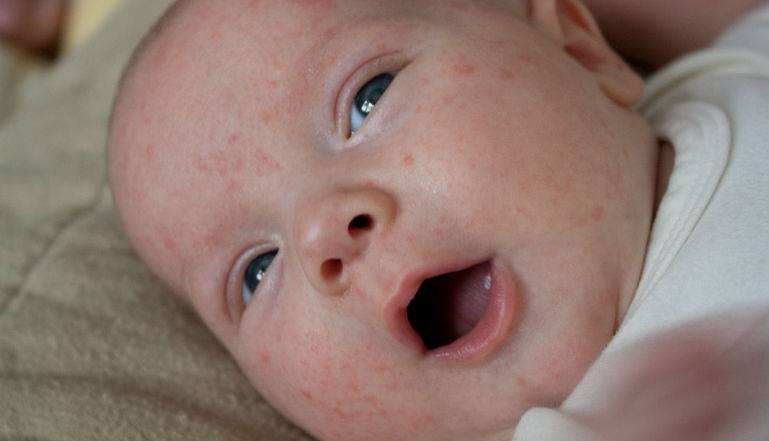
Genetic predisposition plays a major role here. In infants, the most common cause of allergic rashes is allergenic foods (in breast milk, as well as complementary foods).
An experienced specialist will immediately distinguish flowering from allergic symptoms. But parents should also know how to distinguish flowering from allergies in a newborn.
In case of allergies, the doctor will always prescribe professional treatment so that allergic symptoms go away and relapses of the disease do not appear.
If a specialist suspects that the newborn has an allergy and not a flowering problem, a method will be prescribed to determine the irritant.
After identifying the allergen, it may be necessary not only to eliminate contact with the irritant and create a hypoallergenic diet (for the mother, as well as for complementary foods), but also drug therapy with the use of antihistamines (internally and externally) and enterosorbents.
Diagnosis of newborn flowering
Examination of infants with signs of skin bloom takes place in public health institutions or in private clinics. The first option provides free service; there is no need to purchase expensive reagents when ordering a hormone test.
In private clinics, the cost of comprehensive diagnostics of a child’s body varies from 2,500 to 4,000 rubles. depending on the complexity of a particular case.
When making a diagnosis, the attending physician performs the following actions and prescribes tests:
- external examination of the baby’s body, conversation with the mother, conducting a survey on medication intake, diet (is it varied or does the woman consume a certain type of food in excess);
- blood from a finger to perform a general study of biological fluid, establishing its cellular composition, determining glucose levels;
- morning urine, which is collected by parents from 06-00 to 10-00 a.m.;
- blood for the concentration of female and male sex hormones in the baby’s body, which is very important for determining the hormonal nature of the origin of the pustular rash;
- Ultrasound diagnostics of internal organs, if the doctor examining the child suspects the presence of concomitant diseases that affect the health of the skin (pathologies of the liver, gastrointestinal tract, intoxication processes in the body);
- a smear from the surface of the skin in places where the largest amount of rash is localized (this type of analysis must be carried out so that the attending physician has the opportunity to exclude the factor of bacterial, viral or fungal infection of the epithelium).
Based on the results of the above examination methods, the doctor determines the cause of the pustular rash and takes further actions regarding the treatment of the child. If there are signs of an allergic etiology of the disease, allergen tests may be prescribed.
Important to remember
- Most newborns often develop a rash on their face called bloom.
- Parents should know how to distinguish flowering, which is a physiological norm and does not require treatment, from allergies, which must be treated.
- The child should be examined by a pediatrician. If the doctor suspects allergic symptoms, the child will then be treated for the disease by an allergist.
See you in the next article!
Home » Allergies in children »
Any atypical changes in the baby’s skin may indicate a disruption in the functioning of a variety of organs and systems. A common and typical sign is a rash. But it is not only of viral, bacteriological or allergic etiology. There is a so-called bloom in newborns, scientifically called “neonatal cephalic pustulosis”.
Why does the skin of infants bloom?
Doctors are confident that the main reason for skin discoloration in newborns lies in a combination of several factors:
- Hormonal changes. As you know, during pregnancy, mother and child are closely connected with each other. A woman transfers not only blood, oxygen and nutrients to the fetus, but also many hormones. Subsequently, they enter the newborn's body through breast milk. Hormonal fluctuations are most often the main cause of skin discoloration.
- Immaturity of the digestive tract. When a baby is just born, his stomach and intestines are absolutely sterile. The gastrointestinal tract learns to work gradually, it has to get used to a new type of nutrition. Many doctors consider skin discoloration in infants as a so-called “adaptive allergy” and recommend that nursing mothers with this problem be careful when planning their own diet.
- Excessive activity of the sebaceous glands. This reason, according to doctors, is most typical for girls, and proper organization of newborn hygiene helps to somewhat neutralize it.
Despite the fact that doctors were able to determine the causes of flowering in newborns, not a single specialist can answer why this problem bothers only some babies, while the rest of the skin remains absolutely clear.
Description of flowering
On the delicate skin of the baby, reddish or pink pimples (acne) with a white or yellow purulent head appear already on the first day after birth or after 1-2 weeks. They are located very often and are localized on the face - cheeks, forehead, on the nose and under the nose, on the neck, and less often on the head. They do not itch or hurt, there is no swelling. The baby eats and sleeps well and has a normal temperature. Parents may be frightened by the appearance of such a rash in a baby, but they need to know that this is not a dangerous phenomenon.
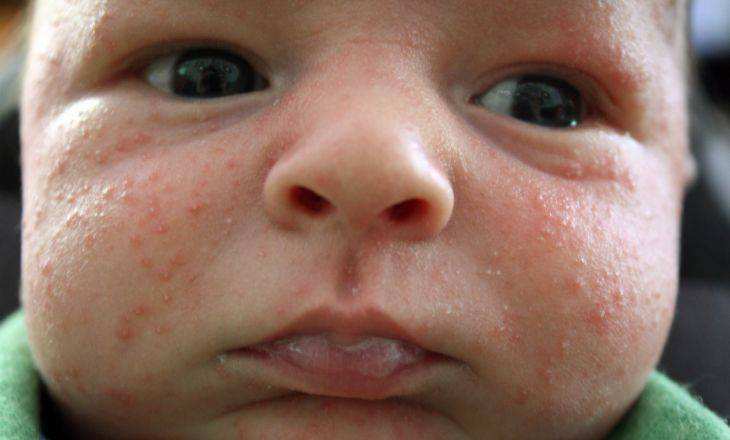
Reasons for appearance
Even before birth, the baby’s body begins to accumulate the female hormone estrogen, transmitted from the mother. Estrogen also continues to be supplied if the baby is breastfed. An excess of the hormone occurs, which is why ulcers appear.
The second reason is that the baby's digestive system is not yet developed enough. An insufficient amount of enzymes necessary for complete digestion of food is produced. Against the backdrop of an excess of hormones, hyperfunction of the sebaceous glands occurs, which begin to work in increased mode. The resulting fat leads to blockage of the sebaceous glands, and then rashes occur.
What should you do when flowering?
When a child blooms, it is considered a natural process. The pustules will go away on their own as soon as the hormonal levels normalize. This period may take up to 3 months.
Maintaining baby hygiene is mandatory. It should be bathed regularly; you can add weak solutions of medicinal herbs to the bath, for example, chamomile, string, St. John's wort, oak bark, etc. The rashes can be lubricated with a cotton swab, which is dipped in jojoba oil or a weak solution of hydrogen peroxide. It is better to agree on the possibility of using such drugs with a pediatrician, since an allergic reaction is possible. You need to use only special children's cosmetics (shampoos, creams, etc.) designed for babies up to one year old. The water should have a comfortable temperature.
Under no circumstances should pimples be crushed, or generously lubricated with creams or self-administered medications . Serious damage to the skin and the addition of a fungal or bacterial infection are possible. In this case, special long-term treatment will be required. Do not wipe the newborn's face with wet wipes, as this increases the secretion of the sebaceous glands. Prohibited are brilliant green, iodine, potassium permanganate solution, antibiotic-based ointments, homemade ointments, various powders, including talc.
It is important for a nursing mother to adjust her menu. Certain foods can affect the level of hormones that cause sebum production. The consumption of fatty foods, smoked meats, fast food, seafood, soft cheeses, and nuts should be reduced to a minimum or completely eliminated. Sweets are limited, especially chocolate and honey. You should be careful when eating all fruits that are red and orange in color, especially citrus fruits. All these products, in addition to increased sebum secretion, can also cause allergies in the baby. Mom needs to drink clean filtered water at least 2 liters per day.
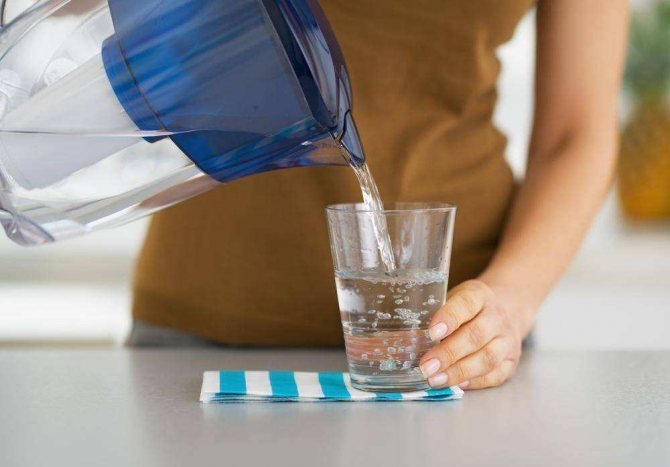
It is strictly prohibited to take medications that balance hormonal levels unless this has been agreed with your doctor. It is also important to try to avoid stress. When a nursing mother is very worried and anxious, the hormone cortisol is released in excess. It also promotes increased activity of the sebaceous glands in the baby.
Special treatment may be required only in cases where severe suppuration is observed. The baby should be shown to a pediatrician.
To help your child's skin clear up faster, your doctor may recommend:
- Spray or cream Panthenol. It softens and soothes the skin, accelerates its regeneration, cleanses, and has an anti-inflammatory effect. Hypoallergenic, has no specific contraindications.
- Zinc ointment. It heals the skin well, removes pustules, and is also suitable for treating diaper rash. It should be borne in mind that in rare cases allergic reactions are possible.
- Ointment Bepanten. Quickly cleanses the skin, dries it, and removes diaper rash. The ointment is clinically safe for children, starting from the first days of life. The only drawback is the relatively high price.
Isn't this an allergy?
Skin rashes in newborns are very often caused by the child’s body’s reaction to nutrients that come with mother’s milk or special formulas, to medications, and to cosmetics. In this case, special treatment is needed.
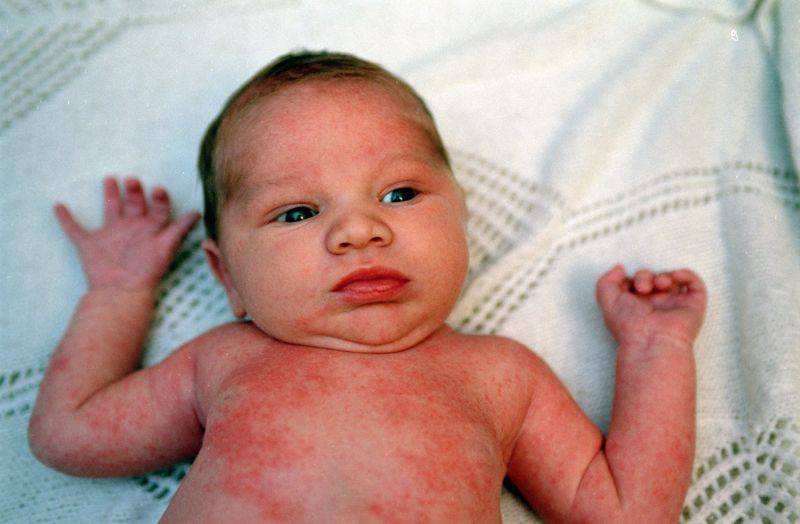
It is necessary to show the child to a pediatrician or allergist. In addition to allergies, staphylococcus, fungal infections, dermatitis, etc. are possible. The specialist will make the correct diagnosis and, if necessary, prescribe therapy. However, there are a number of signs that allow you to independently determine whether an infant has an allergy or a flowering reaction.
Differences:
- With allergies, the rash causes severe discomfort. It itches, the child begins to scratch the affected areas. The skin peels, dries, there is swelling and redness. Due to itching, the baby sleeps poorly, is capricious, appetite decreases, and the temperature may rise;
- pustulosis will go away on its own in a maximum of three months, allergic reactions can drag on for a long period;
- Blooming can be distinguished by the location of the rash. It will only be located on the face, neck and sometimes under the hair. An allergic reaction can occur on any part of the body. It is always associated with some stimulus. If it is a food allergen, the cheeks, buttocks, palms and feet are most often affected. If this is a reaction to a diaper or poor-quality clothing, localization will be in those places that come into contact with these objects;
- Allergy can be distinguished from flowering by the nature of the rash. With an allergic rash there is no purulent head, the spots have a clear outline. They can reach large sizes (with urticaria);
- With allergies, disturbances in the functioning of the gastrointestinal tract are often observed - bloating, pain, flatulence, nausea, vomiting, diarrhea. This is not the case with pustulosis;
- if the baby has allergies, then with the use of antihistamines, enterosorbents and special drops, gels, ointments, a noticeable improvement is quickly observed, and the rash may disappear altogether. With pustulosis, the use of these drugs is pointless and often harmful;
- Signs of an allergy may include excessive mucus from the nose, redness of the eyes and watery eyes, coughing, sneezing, and swelling of the nasopharynx. But we must take into account that these symptoms are characteristic of a number of many diseases. Perhaps the baby just has a respiratory disease.
It is important for parents to understand that flowering is a normal reaction, a sign of the baby’s adaptation to the environment. If certain rules are followed, it does not threaten the child in any way. But if you have the slightest doubt, you should consult a doctor in order to diagnose it in time or eliminate the possibility of more serious complications.
21.07.2017
For any parent, children are the most important thing in life, therefore, as soon as their health worsens or some kind of illness appears, worries and worries begin. And changes in the baby’s body occur constantly, especially in the first year after birth. Therefore, many mothers in the first months after the birth of a little miracle may notice characteristic rashes on the baby’s face and head, which are popularly called neonatal bloom or acne.
Newborn bloom is a very common problem that occurs in many young children. Externally, the rash looks like an allergic reaction, so some doctors mistake the bloom for an allergy, which scares new parents. And if a child begins to be stuffed with allergy medications, then his health can be seriously undermined. Therefore, it is very important to know how to distinguish flowering from allergies in a newborn.
What not to do
You should also determine what not to do if a newborn has such a problem. First of all, do not try to restore hormonal balance on your own. This can lead to irreparable consequences, including failure of some organs. The baby’s body will return to normal over time, without unnecessary interventions.
Also, uncontrolled use of medications is undesirable for an infant. During flowering, it is prohibited to use fat-based anti-acne ointments. They create an airtight film and only make the situation worse. Follow exactly the treatment your pediatrician prescribed.
It is forbidden to squeeze pimples, because this can damage the child’s skin and introduce infection into the wound. Use drying agents carefully and try not to rub the damaged area during hygiene procedures.
Flowering in babies should not be confused with prickly heat and other similar diseases. A doctor will help parents understand and make a correct diagnosis.
Flowering in a newborn, if the distinctive features are not known, can be confused with other skin manifestations. Most often it is compared with problems such as allergies and prickly heat.
In the first case, an allergic reaction is often accompanied by very unpleasant symptoms: lacrimation, itching and redness with small rashes. The rash spreads to the baby's cheeks, chest and arms.
With heat rash, the child’s skin becomes covered with very small pimples, more like subcutaneous tubercles. They itch and cause discomfort to the baby. The largest accumulation of formations occurs in areas of the skin prone to rotting: the groin area, neck, armpits, elbows and knees.
Only a doctor can distinguish flowering from other phenomena. It is indicated by pustules and the absence of unpleasant sensations. Be sure to contact the clinic to clarify the diagnosis, because it could be another dermatological disease or a symptom of internal problems.
Flowering is often only a temporary phenomenon that does not cause much harm to the child. In order to prevent the appearance of such rashes, keep your baby's skin clean, wash him regularly, but do not overdry the epidermis. When the first symptoms appear, immediately consult a doctor, because it is very easy to confuse the diagnosis, and the specific treatment method and the health of the baby depend on this.
About 20% of parents face such a problem as “blooming” of newborns. A rash on the face of your beloved baby can’t help but frighten you. The main difficulty is that it is very easy to confuse it with an allergy. So worried adults begin to stuff the baby with medications, and the nursing mother goes on a strict diet. There is really no need for this, the baby will soon outgrow this problem.
Features of flowering in newborns
Childhood rash appears as a result of improper functioning of the sebaceous glands, which leads to the formation of large pimples in adulthood.
Childhood rash appears as a result of improper functioning of the sebaceous glands, which leads to the formation of large acne in adulthood. It is very rare to meet a person who does not have such a problem. Flowering of newborns is observed immediately after birth or after a couple of days. At 2-3 months of life, acne may appear on the baby’s delicate skin, which lasts up to 12 years. In female newborns, acne appears much earlier than in boys, although male babies are more prone to the formation of dermatological diseases.
In childhood, pimples look like small purulent bumps of a reddish hue, which are localized on the forehead, cheeks or nose. They usually appear in the first weeks of a baby's life. They do not itch, do not cause anxiety to the baby and are clearly visible when the child is in a restless state. Acne occurs as a result of hormonal imbalance, which most often occurs in newborns, teenagers and pregnant women, so infant skin blooms are similar to teenage acne. Cases of such symptoms are observed in 25% of newborns and do not pose a serious threat to the child’s health.
Types of newborn flowering
Flowering of newborns (a photo of the disease reflects the clinical picture of the manifestation of symptoms) is classified by type based on which factor influenced the appearance of the dermatological abnormality.
The table below describes the types of flowering of the skin of infants, as well as their characteristics:
| Type of skin bloom | Description of the pathological process |
| Hormone | Occurs in the first 3 weeks after birth. In the baby's blood there is an increased level of female sex hormones estrogen, which entered the baby's body from the mother during intrauterine development. After 3-4 months. all hormonal substances are eliminated naturally, and the signs of the disease disappear. |
| Allergic | Neonatal pustulosis can occur in children who, from the first days of life, receive mother's milk containing impurities that disrupt the functioning of the baby's body. For example, if a woman has taken or continues to take medications (vitamin and mineral complexes, as well as other medications, the active components of which can cause an allergic rash). |
| Hygienic | This type of skin discoloration in a child occurs in cases where the baby does not receive proper care and his body is parasitized by infectious, viral and fungal microorganisms. In this case, epithelial bloom can manifest itself as either a red rash or individual spots of different diameters. |
| Sebaceous | Irritation of the skin and its negative reaction in the form of rashes on the cheeks, chest, neck, and scalp are associated with overactive activity of the sebaceous glands. Excessive amounts of sebum accumulate on the surface of the child’s skin; fatty compounds clog pores and also become a breeding ground for pathogenic microorganisms. Good hygiene and care for the baby’s sensitive skin can eliminate the symptoms of the disease. |
The type and nature of origin of neonatal pustulosis is determined by a pediatric dermatologist or pediatrician during an external examination of the child. If necessary or if there are suspicions of concomitant diseases in the baby, the doctor may prescribe blood and urine tests. For example, to determine the level of hormones in a child’s body.
Causes of flowering in newborns
Blooming skin in newborns is normal, so don't worry, sudden pimples will go away soon
Often, young mothers, when pimples appear on the baby’s body, begin to think that the reason for this was improper care of the baby or non-compliance with hygiene rules. But this opinion is erroneous, and a newborn can “bloom” in the following cases:
- as a result of a large amount of hormones in the baby’s blood that are transferred from mother to baby in the third trimester of pregnancy;
- imperfect functioning of the baby’s sebaceous glands, which in the first weeks of life are not able to cope with the high load that occurs due to hormonal changes;
- During breastfeeding, hormones continue to be transferred to the baby along with milk, including cortisol, which has a negative effect on metabolism and promotes the production of sebum. It enters the body in moments of excitement and stress, so a nursing mother should worry less and also eat right;
- In very rare cases, blooms in newborns may appear as a consequence of the adaptation of delicate skin to a non-sterile world.
Blooming skin of newborns is normal, so there is no need to worry, and suddenly appeared pimples will soon disappear. But, if a skin rash appears in a one-year-old child or even later, then this is no longer neonatal bloom and you need to consult a doctor to determine the nature of the rash. This could be a sign of an allergic reaction, which is important to detect and treat as soon as possible. Therefore, it is very important to be able to independently distinguish skin discoloration from allergies.
Causes of skin problems
Flowering is caused by hormonal imbalances in the infant body. This occurs due to the active activity of the sebaceous glands, provoked by an increased content of estrogen. It rises sharply in the blood of a pregnant woman in the last trimester. This sex hormone reaches the child during intrauterine development through the umbilical cord and continues to enter the body after birth along with breast milk. The entire time the newborn is freed from excess hormones, his skin will bloom.
Flowering occurs in infants when cortisol gets into the milk. This hormone is released under severe stress. It negatively affects metabolic processes and significantly increases the production of sebum. It is extremely undesirable for young nursing mothers to worry during this period. When you cannot cope with your emotions, you should consult a doctor. He will prescribe sedatives allowed during lactation. Most likely, these will be herbal decoctions and teas based on motherwort, hawthorn, and lemon balm.
Another cause of skin discoloration in a child is a violation of hygiene rules. Due to the increased work of the sebaceous glands, the skin becomes covered with a thin film of fat. It collects dust and impurities, clogs pores, and becomes a favorable environment for the proliferation of microbes. If it is not removed in a timely manner, acne appears.
Doctors note that a woman’s nutrition directly affects the condition of the baby’s skin. Common and seemingly harmless products may contain substances that cause skin discoloration in newborns. Therefore, nursing mothers need to carefully monitor their diet.
Flowering of newborns is considered a physiological process caused by a period of adaptation and cleansing of the baby’s body. It is important not to confuse it with allergic manifestations that require parental and medical attention.
What is the difference between newborn bloom and allergies?
Skin bloom goes away as quickly as it appears and does not require complex treatment
New parents are advised to be aware of how to distinguish allergies from blooms on their own. Having noticed a rash on your baby’s face, you need to make sure that it is a bloom and it will go away on its own. Blooms in newborns at first glance may seem similar to an allergic rash, which also quite often appears in babies aged 1-6 months.
A qualified doctor will immediately make an accurate diagnosis, but you can determine the nature of the baby’s pimples yourself. There are several main differences that allow you to determine whether it is flowering or an allergy in a baby:
- A simple baby rash looks like pimples that are red below and white and purulent above. With allergies, the pimples also have a red tint, but there are no white purulent tops;
- The location of acne varies. In both cases, the rash is on the face, but with flowering it is in the center of the face, then with allergies it is on the cheeks or other parts of the body;
- in case of an allergic reaction, the rash itches and brings discomfort to the baby, which is not observed when the skin blooms;
- in the presence of normal flowering, the child sleeps well and has an excellent appetite, and with allergies, the baby eats and sleeps poorly;
- With allergies, infants may also experience severe redness of the cheeks, changes in stool, the appearance of rough spots, and abdominal pain.
Skin bloom goes away as quickly as it appears and does not require complex treatment. But allergies are a more serious disease that requires immediate treatment, otherwise it can develop into a chronic form and cause concern to the baby for many years. Therefore, you need to see a doctor to make a correct diagnosis.
Symptoms of newborn bloom
Flowering of newborns (a photo of the disease shows in detail the external manifestations of a dermatological problem) has specific signs, the presence of which allows a pediatrician or pediatric dermatologist to suspect the appearance of this particular disease in a child.
Symptoms of neonatal pustulosis are as follows:
- the child’s skin becomes covered with small red spots that have no signs of an inflammatory process, there is no swelling or other symptoms indicating a pathological condition of the epithelium;
- in areas with redness, a small rash forms that is dry to the touch;
- if the cause of the development of a dermatological abnormality is associated with hyperactivity of the sebaceous glands, then in this case, during an external examination of the baby, parents may detect excess fat on the child’s body, the formation of a sebaceous film;
- a red rash covers increasingly large areas of the epithelial surface;
- outwardly the child does not show any signs of anxiety, sleeps well, eats and is not capricious;
- neonatal pustulosis does not cause itching, pain, increased body temperature, and does not cause scratching (unless there is a skin infection in the area where the rash is located).
In conditions of overactivity of the sebaceous glands, the red rash and spots that form on the child’s body may acquire a whitish or yellowish coating. This change in epithelial pigmentation is characteristic of neonatal pustulosis caused by an imbalance of sex hormones. These are those cases when the child’s body still contains an excess amount of estrogens that have passed through the placenta from the mother.
Treatment of newborn flowering
It is recommended to carry out wet cleaning and regular ventilation of the room in which the baby is located.
Many mothers who have a child with a problem such as pimples wonder: is it necessary to treat blooms in newborns? This phenomenon is not allergic or infectious in nature, but is a hormonal rash that does not require treatment. Pimples in newborns go away on their own after the mother's hormones are completely removed from their body and the hormonal system is normalized. The entire recovery process takes no more than 2 months, after which not a trace of the rash will remain.
But you can speed up the healing process. To do this, you must follow the following rules:
- The baby's face should always be clean. You can use mild baby soap as a cleanser, and generally it is best to wipe your face with cotton swabs soaked in chamomile infusion;
- Protect your baby from scratches. A baby's nails should always be cut short to prevent the baby from scratching pimples, which could lead to infection;
- the skin on a newborn’s face should always be dry, since water irritates acne;
- The baby's clothes should always be clean. Regular cleaning of your child's clothes will protect him from various bacteria and germs. Therefore, you need to ensure that all clothes and towels that are used for a newborn are clean and ironed;
- it is necessary to carry out wet cleaning and regular ventilation of the room in which the baby is located;
- Proper nutrition of the mother during breastfeeding also plays a big role for the baby’s health, so it’s worth adding more fruits and vegetables to your diet;
- You can lubricate pimples with a drying ointment, for example, Bepanthen.
If these tips do not bring a positive result and the rash only continues to increase, then you should consult a doctor, as it may be an allergy, the treatment of which is carried out completely differently.
Newborn bloom - what does it mean?
Hello, Lyudmila! Help me, please, deal with this problem. My daughter has small red pimples on her cheeks and chin, in the center of which there are noticeable white dots, like pustules.
I looked on the Internet, but many different diseases fit these symptoms: allergies, prickly heat, flowering in a newborn, diathesis. In each case, treatment advice is different.
But I don’t want to experiment, because the baby is only 3 weeks old. Tell me what this could be and is it necessary to take any emergency measures? You are right, the skin manifestations of the childhood diseases you mentioned are indeed very similar. However, each of them has distinctive features that will help to understand the diagnosis. Your description sounds more like neonatal acne. Pay attention to the peculiarities of the course of this disease and check whether they are observed in your daughter:
The skin around the rash turns red or develops pink, yellowish, or whitish spots. You can often notice that it takes on an oily sheen. They also occur on the neck, shoulders and upper torso. In a boy, pimples can also be seen on the penis. In these places the rash is smaller. Newborn blooms appear in the first month and can last for several weeks.
This period depends on the strength of the baby’s immunity and how quickly he can adapt to new living conditions after birth. During the period of intrauterine development of your baby, you shared with her many valuable substances in your body, including hormones.
Now they come to her through breast milk. As a result of an excess of these, already foreign, biologically active substances, newborns develop a hormonal rash. While still in the stomach, the baby received nutrition from you through the umbilical cord. One way or another, the child is forced to get used to a new type of nutrition. That is, during this period you still need to take a more careful approach to your diet.
Do not aggravate the child's condition. By eating safely, you make the work of the child’s body easier. Your baby's skin will clear up faster. This reason is typical for acne. It can be triggered by the same hormones. Most often, flowering from this occurs in girls. In principle, none of these reasons indicates the presence of any abnormalities in the newborn’s body.
Therefore, flowering in infants is considered a physiological norm, which is characteristic of the process of adaptation and purification that occurs during the newborn period.
No special treatment is required for newborn blooms. Moreover, it is extremely undesirable to interfere with this process. The child’s body must independently get rid of the provoking factor. And he is quite capable of this. Nature itself has designed it in such a way that gradually the functioning of all systems will return to normal, and all foreign elements will be removed from the body or addiction to them will occur.
Treatment for flowering in newborns is usually not prescribed. But, if the rash is too extensive, then consult a pediatrician or dermatologist. You can independently use such folk remedies as lotions based on chamomile or string infusions.
If you remain calm and do not self-medicate, the problem will disappear quickly and unnoticed even without external intervention. The whole truth about flowering in a newborn. Previous Next. What is neonatal flowering: symptoms and manifestations You are right, the skin manifestations of the childhood diseases you mentioned are indeed very similar.
Despite such a scary name, this disease is considered quite harmless. So, if your baby has this particular problem, then you should not worry about this; What does flowering look like in newborns?
There are other signs of newborn bloom. Author: Lyudmila Sharova. Share the article with your friends: Facebook Whatsapp Vk Email.
During flowering, the baby's face is covered with pimples and purulent acne.
Contraindications for flowering newborns
It is strictly not recommended to apply iodine, brilliant green, potassium permanganate, various powders and hormonal creams to rashes
You immediately want to get rid of small purulent pimples by squeezing them out. But this absolutely cannot be done, otherwise acne will only begin to increase and lead to further skin problems and constant trips to the dermatologist. In addition, the wound that remains after a squeezed pimple can become infected, and after it heals, a scar will remain.
It is also not recommended to use various lotions or oils. The fact is that they only clog the skin pores, which leads to the formation of additional acne, which will be more difficult to get rid of. Do not apply iodine, brilliant green, potassium permanganate, various powders and hormonal creams, or other antiseptic drugs to the rashes. There is no need to use any medications; the body will cope with this problem on its own. But consulting a doctor is still necessary, because only he can make the correct diagnosis and give good advice.
Do you think acne is just a teenage problem? It turns out that this unpleasant phenomenon can appear in children even in infancy. Mothers often worry: is this an allergy? After all, everyone wants the baby to be the healthiest! So, let's try to figure out how to distinguish allergies from flowering in newborns.
Causes of newborn blooms
Flowering of newborns (the photo conveys in detail all the symptoms of the current dermatological disease) cannot occur without the influence of one or several factors at once.
The following reasons for the development of neonatal pustulosis are identified based on its type:
- hygienic - appears in cases where for a long period of time the child’s body does not receive proper sanitary care, the baby is swaddled in dirty clothes, parents rarely bathe him, change diapers and do not take care of living conditions;
- hormonal - the most common cause of neonatal pustulosis, which occurs in most of the smallest patients who are admitted to a pediatrician with signs of skin bloom (a physiological reaction of the epithelium is caused by excess estrogen that enters the child’s blood from the mother);
- sebaceous - in the early stages of baby development, the functioning of the endocrine system is stabilized; the glands responsible for the synthesis of sebum may exhibit increased hyperactivity, which ultimately leads to the formation of a fatty film on the baby’s body with the appearance of a pustular rash;
- allergic - the reasons for the manifestation of signs of skin bloom of this type is the reaction of the baby's immune system to substances entering its body along with mother's milk (this is possible if a woman lactating a newborn takes medications, eats a large amount of fruits or foods of the same type, much less often, allergic neonatal pustulosis occurs after contact of the epithelium with fibers of synthetic tissues).
Establishing the causative factors that caused the skin to bloom in a child is a prerequisite for making an accurate diagnosis and further developing a therapeutic course. In 95% of cases, doctors have no difficulty in identifying the source of the irritant, eliminating it and restoring the normal functioning of the child’s epithelium.
Newborn acne: causes, manifestations
Acne in newborns is a common cause of concern for parents
Flowering can be observed in an infant from the very first days of life. It manifests itself as redness on the skin or acne. In most cases, the scalp, face and neck are affected. The color of pimples can be red, yellowish or white.
Sometimes pimples form in the fetus during the prenatal period.
The main causes of acne in a newborn
- Hormonal disorder in the baby: the removal of mother’s hormones occurs too slowly.
- Too much activity of the sebaceous glands.
- Disturbances in the mother's diet during breastfeeding.
Manifestations of flowering in newborns
- Acne on the child's head and cheeks. Sometimes rashes appear on the upper back or chest, or on the baby's neck.
- A small rash on the body that looks like prickly heat.
- The appearance of yellow, white or red spots on the baby’s body.
What is it, symptoms of manifestation
What is this: newborn bloom? This phenomenon is related to dermatological abnormalities. Essentially, these are rashes on the skin of a child at an early age. In other words, this phenomenon is called acne. Minor acne most often affects the baby's cheeks.
If the face is discolored, it is very easy to notice the problem, but sometimes the localization of the formations shifts, and then they are easily confused with other diseases.
The presence of a problem in a newborn is indicated primarily by the following symptoms:
- Acne covering the baby's face. It can also be located directly on the baby’s head and neck.
- The skin turns red and may become covered with whitish, yellowish and pink spots.
- The child’s body is also affected by rashes, but the pimples are somewhat smaller in size than on the face.
- No itching or discomfort. The child does not react in any way to such a problem.
- Abundant discharge from the sebaceous glands, the face is covered with a thin film of fat.
If you notice anything like this, immediately contact your pediatrician, but under no circumstances use traditional methods and standard medications without prior consultation and a correct diagnosis.
Infant skin blooms are also called newborn acne.
Newborn allergies
Eczema as an example of an allergy manifestation on a baby's face
The main causes of allergies in children in the first months of life are the mother’s consumption of “forbidden” foods during feeding, violation of the diet during pregnancy (abuse of high-calorie foods, citrus fruits, red and orange fruits and vegetables, chocolate, honey, nuts), incorrect or too abrupt introduction of complementary foods.
The risk of allergic diseases in young children is increased by infectious diseases they have suffered, a hereditary factor, and fetal hypoxia during pregnancy. One should not discount the insufficient development of the child’s digestive system.
It is a common misconception that breastfeeding provides 100% protection for a child from allergic diseases.
How to distinguish allergies from flowering?
Pimples on a baby's face close-up
The cause of a rash on a child’s body can be an allergic reaction, prickly heat, or acne. How to distinguish: allergies or newborn blooms are the cause of the rash?
Miliaria usually forms in places where the child’s body comes into contact with clothing, under the arms, and in folds of the skin. The pimples themselves are small, without liquid inside.
When flowering, the child's skin becomes bright red, sometimes with a yellowish tint. If the pimples are large and there is a watery liquid inside them, it means that the reason for their appearance is the insufficiently correct functioning of the baby’s sebaceous glands.
An allergic rash differs from a bloom in that it can appear on any part of the body. Unlike acne, allergic acne is very itchy. Sometimes suppuration may begin in places where clothing comes into contact with the skin. If your child has allergies, you will not be able to get by with hygiene measures. You need to adjust your diet and decide what is allowed.
The main difference between newborn acne and allergies is that the allergic rash can be spread throughout the body and peel off.
Prevention of flowering of newborns
In order to prevent the skin of newborns from blooming, it is necessary to follow simple rules for caring for infants, which consist of performing the following actions on the part of the baby’s parents:
- bathe the child daily in warm water using hypoallergenic baby soap;
- do not use medications during the period of breastfeeding, unless there are direct medical indications for their use (especially for medications containing natural or synthetic hormones);
- dress the newborn only in clothes made from natural fabrics (cotton, linen), avoid the use of synthetic fibers, which can cause irritation of the epithelial layer and cause an allergic reaction;
- During the period of lactation of a child with breast milk, a woman should eat properly, exclude harmful foods that have no biological value from her diet, consume citrus fruits, chicken eggs, fish, nuts, honey, milk, and meat in moderation;
- monitor the activity of the newborn’s sebaceous glands so that they do not become overactive;
- if for some reason the mother cannot lactate the baby, then only high-quality formulas that replace breast milk should be used;
- When going for a walk, always dress the baby in accordance with the weather conditions, do not allow his body to overheat, so that prickly heat, diaper rash and prerequisites for flowering do not occur.
At the first reddening of the skin and the formation of a red rash, you should always go to the hospital. Refusal of self-medication is the first rule for the prevention of dermatological diseases, which may ultimately become a prerequisite for the development of neonatal pustulosis in newborns.
Therapeutic measures during flowering
Neonatal rash may last up to 3 weeks
In any case, if you find a rash on your baby’s body, under no circumstances try to diagnose it yourself! Make an appointment with your local pediatrician and be sure to take all tests. It is he who can tell you how to distinguish acne from allergies in newborns or, say, from prickly heat. Based on the appearance of the rash alone, it is impossible to determine one hundred percent what it is: an allergy, staphylococcus or a fungal infection of the skin.
Flowering is a sign of the baby’s adaptation to the outside world, a kind of cleansing of the body from maternal hormones. Moreover, many pediatric doctors consider flowering to be normal, so there is no reason to panic. It is only important to correctly distinguish flowering from other types of rashes in order to take timely measures. In addition, the flowering process can take place on its own, without any outside intervention.
Under no circumstances should you allow pimples to be squeezed or use fatty ointments for treatment.
An important requirement is to keep the child's skin clean at all times. After washing, dry the child’s skin with gentle movements.
Your pediatrician may prescribe zinc ointment to dry out the pimples a little. But it must be used with some caution so as not to dry out the skin too much. Hydrogen peroxide, applied in the form of dots using cotton swabs, will also help (you can use hydrogen peroxide twice a day, not more often!).
Treatment with decoctions of chamomile and string (one teaspoon of each component per glass of boiling water) has a good effect on the skin. Bepanten, applied to the skin in a thin layer 1-2 times a day, also dries out pimples.
The duration of flowering varies for many babies. In some children, pimples disappear without a trace within a few days. Usually the phenomena disappear completely by the age of three months, without any treatment. In rare cases, pimples remain until the age of one. On average, the duration of newborn acne ranges from several weeks to one and a half months.
Important!
As a rule, acne occurs without symptoms and does not cause any concern to the child. Discomfort may arise from improper treatment measures. Under no circumstances do the treatment yourself, as you risk provoking purulent eczema in the child. Infection can easily penetrate through damaged skin.
It is very important to maintain ideal cleanliness and sterility, as well as proper nutrition.
Doctor
Treatment options
How to get rid of such a rash? In order to eliminate pimples of this origin, no specific treatment or medications are required. In most cases, it is enough to follow only general recommendations.
Your pediatrician will tell you what measures are needed specifically in your case. It is imperative to go to see him, since an incorrect diagnosis can lead to adverse consequences.
First of all, during pregnancy and breastfeeding, you should never take hormonal medications. If you suffer from any serious medical condition, the use of these medications should be strictly supervised by your doctor. At the same time, you need to monitor the baby’s well-being.
The main method of preventing and combating infant bloom is compliance with all hygiene measures: washing, bathing, lubricating the body and face with special care products, etc.
Be sure to adjust your diet while breastfeeding. This will help prevent the development of other diseases, including, and will also have a positive effect on the formation of a small organism. A special diet does not imply strict restrictions at all.
The child must be clean and well-groomed. Responsibility for this falls entirely on the shoulders of the parents. It needs to be washed daily. To care for your baby's delicate skin, use only clean water and special baby products without any additives, dyes or flavors. If there is no access to water, use baby sanitary napkins, but this is rather a last resort.
After the water procedures are completed, you need to gently dry the baby's skin. To do this, it is better to use not even a towel, but dry paper napkins. You need to work with light blotting movements.
If severe rashes appear, you can use pharmaceutical medications with the permission of your doctor. First of all, these are special antiseptic ointments containing zinc. They perfectly dry out pimples and disinfect the skin, creating an antiseptic barrier for germs. Hydrogen peroxide can also be used, but it can dry out the baby's delicate skin.
Traditional methods allow the use of rinses based on decoctions of some herbs. First of all, it is chamomile and string. It is better not to use long-term compresses, as this can provoke the development of an allergic reaction in addition to flowering.
If you follow these recommendations, flowering will soon pass. It usually lasts several weeks, but can go away on its own in the first 3 days or last up to 2-3 months. This is especially true for children with hormonal imbalances.
